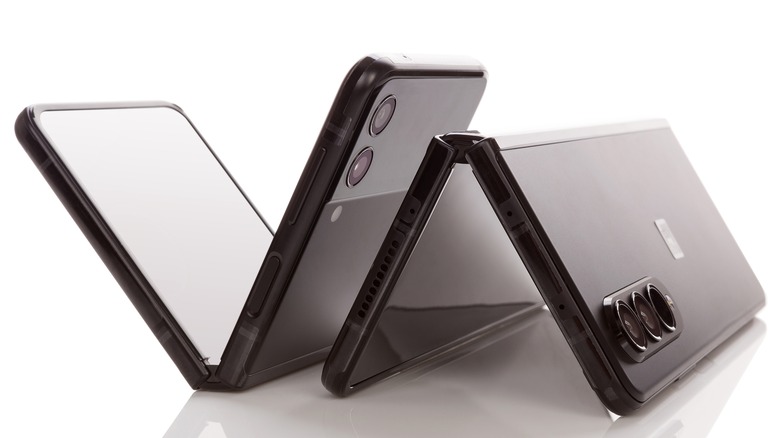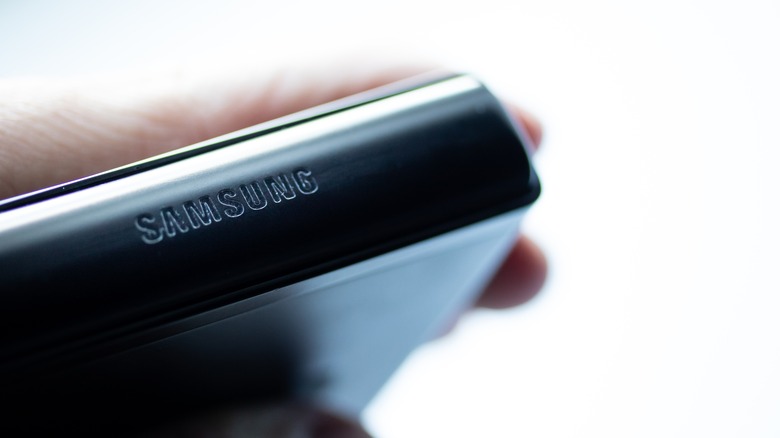The Real Reason Samsung Isn't Using A Waterdrop Hinge For Its Foldables
Samsung may have just announced its latest generation of foldable phones, but its thunder was quickly stolen by some very close rivals. Motorola finally held its delayed event and revealed the Motorola Razr (2022) to take on the new Galaxy Z Flip 4 foldable clamshell. Xiaomi, on the other hand, revealed its own Galaxy Z Fold 4 rival, the Mix Fold 2. The Chinese brand's limited availability almost makes competition moot in global markets, but there is one area where it does seem to do better than Samsung. Just like Huawei and Oppo, Xiaomi employed a waterdrop-style hinge to make the Mix Fold 2 fold flatter and thinner. Despite that advantage, however, Samsung is apparently snubbing this design for a simple yet important reason.
The hinge of a foldable phone isn't just critical for keeping the two halves of the phone together or doing its seemingly magical folding trick. The hinge also determines how the flexible screen is folded, how much curvature and tension there is, and how durable and reliable the foldable phone becomes. That, in turn, affects the creasing of the display and, in the long run, the longevity of the fragile screen.
Samsung has so far been using a more conventional hinge mechanism that leaves a visible gap to allow for the minimum curvature for a foldable panel. This is why the Galaxy Z Fold and Galaxy Z Flip don't fold flat, leaving a gap near the hinge. In contrast, the hinge used by Xiaomi, Huawei, and Oppo employs a mechanism that makes the central part of the display sink inside of the body when folded, creating a waterdrop shape. Despite praises for the mechanism, Samsung apparently thinks it's not worth the cost in terms of overall reliability.
The waterdrop hinge design comes with major compromises
The waterdrop hinge allows a foldable phone to fold flat and is believed to be the reason why the screen's crease is also less visible. With the Xiaomi Mix Fold 2, the hinge has also been credited for allowing the foldable phone to be thinner, as well. One would think that Samsung, being an expert in displays, would have already employed such a design by now. Apparently, the company looked into it but ultimately decided against the option.
Display Supply Chain Consultant's Ross Young revealed (via SamMobile) that Samsung did test something similar to a waterdrop hinge design during its R&D phase. It found out, however, that adopting this kind of hinge would mean dropping Samsung's prized IPX8 rating for something that's just "water-resistant." Considering Samsung's policy of making expensive phones rightly waterproof, that just wouldn't do. We first heard rumbles about this topic from etnews back in March 2022.
To be fair, Samsung may have chosen the correct trade-offs, at least for now. Despite not being exactly pretty, the hinge Samsung uses doesn't take away any critical functionality and isn't less durable than waterdrop hinges. The crease is still a problem, but every iteration seems to improve the situation bit by bit. This just shows that we still have a ways to go before we have the perfect, flat-folding foldable phone, and Samsung hopefully hasn't given up yet on making sure that happens. The rise of other foldable phones is also a good motivator for Samsung not to rest on its laurels and instead keep pushing the envelope until it develops the perfect combination.

